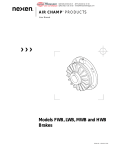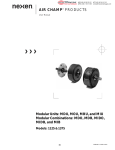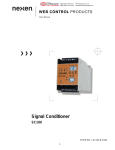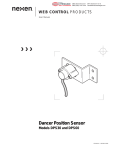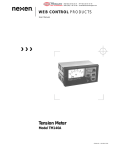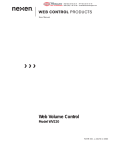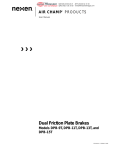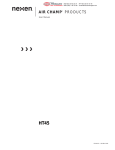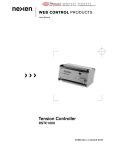Download RSD250 Web Dancer Controller System 21179
Transcript
® MEX (55) 53 63 23 31 DIST. AUTORIZADO QRO (442) 1 95 72 60 MTY (81) 83 54 10 18 [email protected] WEB CONTROL PRODUCTS User Manual RSD250 Unwind Dancer Package FORM NO. L-21179-B-1003 1 FORM NO. L-21179-B-1003 ® MEX (55) 53 63 23 31 DIST. AUTORIZADO QRO (442) 1 95 72 60 MTY (81) 83 54 10 18 [email protected] In accordance with Nexen’s established policy of constant product improvement, the specifications contained in this manual are subject to change without notice. Technical data listed in this manual are based on the latest information available at the time of printing and are also subject to change without notice. Technical Support: 800-843-7445 (651) 484-5900 www.nexengroup.com DANGER Read this manual carefully before installation and operation. Follow Nexen's instructions and integrate this unit into your system with care. This unit should be installed, operated and maintained by qualified personnel ONLY. Improper installation can damage your system or cause injury or death. Comply with all applicable codes. Nexen Group, Inc. 560 Oak Grove Parkway Vadnais Heights, Minnesota 55127 ISO 9001 Certified Copyright 1999 Nexen Group, Inc. FORM NO. L-21179-B-1003 2 ® MEX (55) 53 63 23 31 DIST. AUTORIZADO QRO (442) 1 95 72 60 MTY (81) 83 54 10 18 [email protected] Table of Contents Introduction --------------------------------------------------------------------------------------------------------------------------- 4 RSD250 Overview ----------------------------------------------------------------------------------------------------------------- 4 Installation ----------------------------------------------------------------------------------------------------------------------------- 4 Electrical and Pneumatic Connections --------------------------------------------------------------------------------- 5 Setup and Calibration ------------------------------------------------------------------------------------------------------------- 6 Jumper Setting ---------------------------------------------------------------------------------------------------------------- 6 Provide Power ----------------------------------------------------------------------------------------------------------------- 6 Calibrate DPS60 ------------------------------------------------------------------------------------------------------------- 6 Start / Stopped Signal Selection ---------------------------------------------------------------------------------------- 7 Tuning ----------------------------------------------------------------------------------------------------------------------------------- 9 Gain ------------------------------------------------------------------------------------------------------------------------------ 10 New Roll Adaptation ------------------------------------------------------------------------------------------------------- 10 Specifications ---------------------------------------------------------------------------------------------------------------------- 11 Part Numbers ---------------------------------------------------------------------------------------------------------------------- 11 Parts List ---------------------------------------------------------------------------------------------------------------------------- 11 Warranty ----------------------------------------------------------------------------------------------------------------------------- 14 3 FORM NO. L-21179-B-1003 ® MEX (55) 53 63 23 31 DIST. AUTORIZADO QRO (442) 1 95 72 60 MTY (81) 83 54 10 18 [email protected] INTRODUCTION The Nexen RSD250 Unwind Dancer Package consists of all the essential components necessary for state-of-the-art dancer arm control. This system is designed for unwind applications using a pnuematic brake. Included in the kit is a RSD250 controller, DPS60 dancer arm position sensor, EN50 pressure converter, air supply filters, and air line tubing. The RSD250 controller is housed inside an enclosure that only requires 120 or 240 VAC service to be wired in. All DPS60, EN50, and external signal connections are made to the RSD250 via pre-wired connectors. Additionally, all the pneumatic connections are made using tool-less quick connect fittings; thus connecting components together is fast and easy with little chance of error. This system has been pre-configured for unwinding applications using pneumatic brakes. Essential setup parameters are set so only the DPS60 must be calibrated and the proper Start/Stopped signal selected by the installer. After the installation is complete, the RSD250 is tuned to the application using two potentiometers located on the main control board. Other setup and tuning parameters may need to be adjusted to accommodate more demanding applications and the RSD Communications Kit (See Part Numbers Section) can be purchased separately and used to adjust all parameters. RSD250 OVERVIEW As a roll changes diameter, a dancer control must adapt to the corresponding changes in speed, inertia and torque if high dancer performance is desired. High dancer performance not only ensures constant tension, it allows for faster machine accelerations and decelerations, which means more production on many machines. The RSD250 is a truly adaptive controller and will adapt its response to changing roll diameter and inertia conditions. This ensures that the RSD250 will always provide the right amount of action for stable dancer arm performance. Other benefits: 1) Diameter sensing is not necessary 2) Splicing different size rolls without readjustment 3) Excellent performance at slow web speeds and on small rolls. INSTALLATION CAUTION Mount all the R S D25 0 Basic Dancer Kit components in a shoc k and vibration free area with RS D250 shock an ambient temperature of less than 140°F [60°C] and more than 32°F [0°C]. For installation instructions for the EN50 and DPS60 refer to their maintenance manuals (included with this kit). FORM NO. L-21179-B-1003 4 ® MEX (55) 53 63 23 31 DIST. AUTORIZADO QRO (442) 1 95 72 60 MTY (81) 83 54 10 18 [email protected] ELECTRICAL AND PNEUMATIC CONNECTIONS RSD250E User Supplied Air Input AIR SUPPLY FILTER 100-240 VAC 50/60 HZ Supply Connections EN50 User Supplied Contacts DPS60 Start/Stopped Brown White Splice Brake Air Pressure Output Digital Inputs Blue Figure 1 Table 1 Digital Inputs Function Cable Wire Start/Stop Brown Splice White Common Blue none Black Shield Shield Drain Cable Pin 1 2 3 4 5 ON/OFF Power Switch Receptacle Wire Brown White Blue Black Green/Yellow L1 Circuit Breaker L2 AC Power Connections Earth Ground Figure 2 Table 3 Table 2 DPS60 EN50 Function + Signal - Signal Ground Din Connector 1 2 Ground Cable Wire Cable Pin Brown Blue Black Shield 1 3 4 2 Recepticle Wire Brown Blue Black White 5 Connector Receptacle Pin Wire Brown 1 Brown Blue 3 Blue Black 4 Black Orange 2 White Drain 5 Gray Function DPS60 +12 VDC DC Com Output 1 Output 2 Shield FORM NO. L-21179-B-1003 ® MEX (55) 53 63 23 31 DIST. AUTORIZADO QRO (442) 1 95 72 60 MTY (81) 83 54 10 18 [email protected] SETUP AND CALIBRATION JUMPER SETTING Set W2 to position two (factory default). This jumper must be in position two before calibrating the DPS60 or tuning the controller. PROVIDE POWER Provide 120 or 240 VAC service to the RSD250 that meets local electrical codes (See Electrical and Pneumatic Connections section for connection information). After providing VAC power turn RSD250 on with circuit breaker disconnect switch (See Figure 2). Check the green LEDs, I1 and I2, on RSD250 to make sure both are on. R20 R19 U4 CALIBRATE DPS60 After installing and connecting the DPS60 dancer arm position sensor, the next step is to calibrate it. Indicator 1. Place the dancer arm in the maximum storage position. Rotary Switch 2. Rotate the rotary switch on the RSD250 to position E (See Figure 3). LED I7 will begin blinking; after approximately ten seconds it will stay on for two seconds, then turn off. I7 1 W2 2 While the LED is blinking the dancer arm can be moved; Once the LED is on continuously the RSD250 will have captured the arm’s position. Jumper Figure 3 3. Place the dancer arm in the minimum storage position (See Figure 3). 4. Rotate the rotary switch on the RSD250 to position F (See Figure 3). LED I7 will begin blinking; after approximately ten seconds it will stay on for two seconds, then turn off. While the LED is blinking the dancer arm can be moved; Once the LED is on continuously the RSD250 will have captured the arm’s position. FORM NO. L-21179-B-1003 6 I2 I1 ® MEX (55) 53 63 23 31 DIST. AUTORIZADO QRO (442) 1 95 72 60 MTY (81) 83 54 10 18 [email protected] START/STOPPED SIGNAL SELECTION The RSD250 determines the start/stopped state of a machine through the Start/Stopped Signal Input. The RSD250 was designed to accommodate many different types of machine state signals. The following figure and descriptions detail the variations of Start/Stopped signals that the RSD250 accepts. After choosing the appropriate signal, set the rotary switch on the RSD250 printed circuit board per Table 4. 100% Machine Speed 0% Time (1) Start / Stopped (Maintained) (2) Start / Stopped (Momentary) -t- Pulse Time (t) must be > 100ms (5) Start Only (Momentary) (6) Encoder (Pulses) Figure 4 START/STOPPED SIGNAL DESCRIPTIONS Start / Stopped Signal (Maintained) When the Start/Stopped input signal is maintained low, the RSD250 assumes the machine is stopped. When the Start/Stopped input signal transitions to a maintained high, the RSD250 algorithm will begin adapting to account for the roll’s diameter and inertia. The web must be in motion when this signal goes high otherwise the Adaptive Gain will increase to maximum. After the Start/Stopped signal transitions back to low, the Adaptive Gain will stop adapting and remain a constant value. Start / Stopped Signal (Momentary) When the Start/Stopped input signal pulses high, the RSD25 0 algorithm will begin adapting to account for the roll’s diameter and inertia. The web must be in motion when this signal goes high otherwise the Adaptive Gain will increase to maximum. After the Start/Stopped signal pulses high a second time, the Adaptive Gain will stop adapting and remain a constant value, because the RSD250 assumes the machine has stopped. 7 FORM NO. L-21179-B-1003 ® MEX (55) 53 63 23 31 DIST. AUTORIZADO QRO (442) 1 95 72 60 MTY (81) 83 54 10 18 [email protected] Start Only Signal (Momentary) When the Start/Stopped input signal pulses high, the RSD250 algorithm will begin adapting to account for the roll’s diameter and inertia. The web must be in motion when this signal goes high otherwise the Adaptive Gain will increase to maximum. After the machine stops, the RSD250 will continue trying to adapt until the Start/ Stopped input pulses high again and causes the adaptation process to start over. Encoder (Pulses) The first time a machine driven encoder pulses the Start/Stopped input, the RSD250 algorithm will begin adapting to account for the roll’s diameter and inertia. The web must be in motion when this signal goes high otherwise the Adaptive Gain will increase to maximum. The RSD250 will continue to actively adapt until the encoder pulses cease for three seconds. At that time, the RSD250 will assume the machine has stopped and the Adaptive Gain will become to a constant value. Table 4 Rotary Switch Position Determine which signal type your machine uses and set the Rotary Selection Switch. Start/Stopped Signal 0 Not Used 1 Start / Stopped (Maintained) 2 Start / Stopped (Momentary) 3 Not Used 4 Not Used 5 Start Only (Momentary) 6 Encoder (Pulses) FORM NO. L-21179-B-1003 8 ® MEX (55) 53 63 23 31 DIST. AUTORIZADO QRO (442) 1 95 72 60 MTY (81) 83 54 10 18 [email protected] TUNING A typical unwind application begins with a new full roll. To insure that the dancer arm stabilizes as quickly as possible, the SPLICE signal can be used to reset adaptation to NEW ROLL ADAPTATION before the machine starts. This shortens the time it takes for the RSD250 to adapt its gains to the new roll. As the roll begins to accelerate, the dancer arm will seek its home position. Over time the roll will decrease in size along with RSD250’s output and control gains. During constant speeds the dancer arm will remain stable, but the output signal will not be steady. During a machine stop, the adaptation process will increase the RSD250’s output and gains in order to overcome the roll’s inertia. If a SPLICE signal is not used, the dancer arm may be sluggish on the first start with a full roll. This is because the adaptation process will begin at a minimum adaptation value and take longer to reach the optimum gain level. Once the RSD250 adapts to the new roll, the adaptation process will level off and on subsequent starts the arm will quickly move into position. During a run, the adaptation process continually adjusts the gains to account for changes in roll size. When the RSD250 is in STOPPED mode, the adaptation process is halted. However, the RSD250’s output will still change depending on the dancer arm’s position. After the next START signal is given, the RSD250 adaptation will begin adapting again. Any time the SPLICE signal is given, the adaptation process will be reset to NEW ROLL ADAPTATION. This is useful after a web break where the adaptation process could increase the RSD250’s gain too high resulting in an unstable dancer arm at the next machine start. It can also be reset to the minimum adaptation value by moving the dancer arm to its maximum storage position while the RSD250 is stopped. When the START signal goes high at the Start/Stopped input, the RSD250 will begin adapting. The web must begin to move at this instant. Large Roll Small Roll Optimum Gain Reached Adaptation New Roll Adaptation Min. Adaptation Run Speed Acceleration Run Speed Acceleration Deceleration Deceleration Stopped Splice Signal Start/Stopped Signal Figure 5 NOTE: Only GAIN and NEW ROLL ADAPTATION can be adjusted via potentiometers on the RSD250’s printed circuit board. For access to all RSD250 setup and tuning parameters, you must use the RSD Communications Software Kit. 9 FORM NO. L-21179-B-1003 ® MEX (55) 53 63 23 31 DIST. AUTORIZADO QRO (442) 1 95 72 60 MTY (81) 83 54 10 18 [email protected] GAIN Note: Gain must be adjusted first, because it affects all tuning parameters and controls how the dancer arm responds to errors. Gain is adjusted by rotating a potentiometer, R19, on the RSD250 printed circuit board (See Figure 6). To increase, turn clockwise; to decrease, turn counterclockwise. Adjust Gain one half turn at a time. New Roll Adaptation 1. Operate the machine at a slow run speed with a nearly full roll. R20 R19 2. When the machine is at a constant speed, allow about ten seconds for the RSD250 to adapt. Gain Indicator a) Change the machine speed to introduce a dancer arm disturbance. The dancer arm will move and return to its operating position quickly with little or no overshoot. Rotary Switch U13 I7 1 W2 I3 2 I4 b) If the arm is slow to reach it operating position, increase Gain and repeat the test. I2 I1 c) If dancer arm becomes unstable after a speed change, decrease Gain and test again. Figure 6 NEW ROLL ADAPTATION New Roll Adaptation is adjusted by rotating a potentiometer, R20, on the RSD250 printed circuit board (See Figure 6). To increase, turn clockwise; to decrease, turn counterclockwise. Adjust New Roll adaptation one turn at a time. NEW ROLL ADAPTATION is the beginning adaptation value that the RSD250 will adapt from after receiving a Splice signal. The closer this value is to the actual adaptation value the shorter the time required for the RSD250 to adjust itself to actual roll conditions; so NEW ROLL ADAPTATION needs to be set for a new roll. NOTE: If a machine is started with a new roll smaller than the roll used to set NEW ROLL ADAPTATION, the controller gain could be too high, causing the dancer arm to become unstable. Unwind applications begin with new rolls and run them down to their core diameter. Some unwind applications start with the same diameter roll every time; others start with rolls of various diameters. NEW ROLL ADAPTATION should be set to the smallest diameter new roll run under minimum tension conditions. 1. Load the smallest diameter new roll on the machine and set the web tension to minimum. 2. Momentarily apply the splice signal. 3. Start the machine and note if dancer arm stabilizes quickly about its operating position. 4. If arm is unstable or takes an excessive amount of time to settle down, then decrease NEW ROLL ADAPTATION. If arm is very sluggish to start, then increase NEW ROLL ADAPTATION. Repeat steps 2 and 4. 5. Unwind the roll and check periodically that dancer arm quickly returns to its operating position after each start up as the roll becomes smaller. FORM NO. L-21179-B-1003 10 ® MEX (55) 53 63 23 31 DIST. AUTORIZADO QRO (442) 1 95 72 60 MTY (81) 83 54 10 18 [email protected] SPECIFICATIONS Power .............................. 100–240 VAC, 12 VA, 50/60 Hz Air Supply .......................... 90–150 psig [630–1050 kPa] Temperature ....... RSD250: 32°F – 140°F [0°C – 60°C] ................................. Air Filter: 40°F – 120°F [4°C – 50°C] Digital Inputs..................... 12–24 VDC @ 24mA maximum PART NUMBERS RSD250 Unwind Dancer Package: 964260 RSD Communications Kit: 964521 PARTS LIST RSD250 STARTER KIT 1 3 6 6 2 Digital Inputs 4 5 ITEM DESCRIPTION QTY 1 2 RSD250E Controller EN50-85V with Cable 1 1 3 Prefilter & Coalescing Filter 1 4 DPS60 With Connector 1 5 Nylon Tubing (.156 diameter) 1 6 Nylon Tubing (.250 diameter) 1 Figure 7 11 FORM NO. L-21179-B-1003 ® MEX (55) 53 63 23 31 DIST. AUTORIZADO QRO (442) 1 95 72 60 MTY (81) 83 54 10 18 [email protected] RSD250E 5 14 15 2 6 7 1 9 4 10 13 9 3 8 16 20 17 12 3 22 23 24 21 Figure 8 ITEM DESCRIPTION QTY ITEM DESCRIPTION QTY 1 RSD250E Basic Enclosure 1 13 Dome Plug 3 2 3 Mounting Panel Enclosure Pan Head Slot Screw (.165-32) 1 4 14 15 Wire (Green / Yellow) Terminal Ring (.190 Stud) 6 in. 1 4 RSD250 Assembly (Open Cover) 1 16 Marker Strip (1-10) 1 5 Din Rail (35 mm) 1 17 Marker Strip (11-20) 1 6 End Bracket 2 18 Red Wire (20 Awg) 12 in. 7 Circuit Breaker 1 19 Black Wire (20 Awg) 12 in. 8 Terminal Block 11 20 Pan Head Slot Screw 2 9 10 12 Grounding Terminal Block IDEC Power Supply (24 V) Power & Signal Cable 2 1 1 21 22 23 24 Rear Mount Receptacle (4 Conductor) Rear Mount Receptacle (5 Conductor) Rear Mount Receptacle (Rev Key, 5 Cond) Shielded Cable (4 Cond, Mail Connector) 1 1 1 1 FORM NO. L-21179-B-1003 12 ® MEX (55) 53 63 23 31 DIST. AUTORIZADO QRO (442) 1 95 72 60 MTY (81) 83 54 10 18 [email protected] EN50–85 V, WITH CABLE ITEM 2 1 DESCRIPTION QTY 1 Assembly (with conn.), 0-85 psi 1 2 Shielded Cable, Female (3 Conductor) 1 3 .25 NPT Straight Fitting, (.156 Tube) 1 4 .25 NPT Straight Fitting (.25 Tube) 2 4 3 Figure 9 PREFILTER & COALESCING FILTER ITEM DESCRIPTION QTY 1 Filter, Coalescing & Prefilter, 20 SCGM 1 2 Push-in Tube Fitting 2 1 2 Figure 10 DPS60 WITH CONNECTOR 5 8 ITEM DESCRIPTION QTY 7 1 2 DPS60 Assembly with Connector Mounting Bracket 1 1 3 Pan Head Machine Screw 2 4 Flat Washer 2 5 Spring Lock Washer 4 6 7 8 10 Hex Nut Pan Head Machine Screw Stub Shaft Serial Sticker 2 2 1 1 2 4 5 6 1 10 3 Figure 11 13 FORM NO. L-21179-B-1003 ® MEX (55) 53 63 23 31 DIST. AUTORIZADO QRO (442) 1 95 72 60 MTY (81) 83 54 10 18 [email protected] WARRANTY Warranties Nexen warrants that the Products will be free from any defects in material or workmanship for a period of 12 months from the date of shipment. NEXEN MAKES NO OTHER WARRANTY, EXPRESS OR IMPLIED, AND ALL IMPLIED WARRANTIES, INCLUDING WITHOUT LIMITATION, IMPLIED WARRANTIES OF MERCHANTABILITY AND FITNESS FOR A PARTICULAR PURPOSE ARE HEREBY DISCLAIMED. This warranty applies only if (a) the Product has been installed, used and maintained in accordance with any applicable Nexen installation or maintenance manual for the Product; (b) the alleged defect is not attributable to normal wear and tear; (c) the Product has not been altered, misused or used for purposes other than those for which it was intended; and (d) Buyer has given written notice of the alleged defect to Nexen, and delivered the allegedly defective Product to Nexen, within one year of the date of shipment. Exclusive Remedy The exclusive remedy of the Buyer for any breach of the warranties set out above will be, at the sole discretion of Nexen, a repair or replacement with new, serviceably used or reconditioned Product, or issuance of credit in the amount of the purchase price paid to Nexen by the Buyer for the Products. Limitation of Nexen’s Liability TO THE EXTENT PERMITTED BY LAW NEXEN SHALL HAVE NO LIABILITY TO BUYER OR ANY OTHER PERSON FOR INCIDENTAL DAMAGES, SPECIAL DAMAGES, CONSEQUENTIAL DAMAGES OR OTHER DAMAGES OF ANY KIND OR NATURE WHATSOEVER, WHETHER ARISING OUT OF BREACH OF WARRANTY OR OTHER BREACH OF CONTRACT, NEGLIGENCE OR OTHER TORT, OR OTHERWISE, EVEN IF NEXEN SHALL HAVE BEEN ADVISED OF THE POSSIBILITY OR LIKELIHOOD OF SUCH POTENTIAL LOSS OR DAMAGE. For all of the purposes hereof, the term “consequential damages” shall include lost profits, penalties, delay images, liquidated damages or other damages and liabilities which Buyer shall be obligated to pay or which Buyer may incur based upon, related to or arising out of its contracts with its customers or other third parties. In no event shall Nexen be liable for any amount of damages in excess of amounts paid by Buyer for Products or services as to which a breach of contract has been determined to exist. The parties expressly agree that the price for the Products and the services was determined in consideration of the limitation on damages set forth herein and such limitation has been specifically bargained for and constitutes an agreed allocation of risk which shall survive the determination of any court of competent jurisdiction that any remedy herein fails of its essential purpose. Limitation of Damages In no event shall Nexen be liable for any consequential, indirect, incidental, or special damages of any nature whatsoever, including without limitation, lost profits arising from the sale or use of the Products. Warranty Claim Procedures To make a claim under this warranty, the claimant must give written notice of the alleged defect to whom the Product was purchased from and deliver the Product to same within one year of the date on which the alleged defect first became apparent. Nexen Group, Inc. 560 Oak Grove Parkway Vadnais Heights, MN 55127 800.843.7445 Fax: 651.286.1099 www.nexengroup.com ISO 9001 Certified FORM NO. L-21179-B-1003 14














